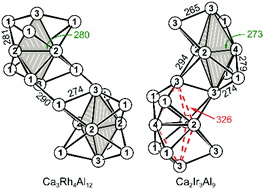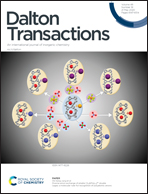On the formation of the Gd3Ru4Al12versus the Y2Co3Ga9 type structure – M3Rh4Al12 (M = Ca, Eu) versus M2T3Al9 (M = Ca, Sr, Eu, Yb; T = Ir, Pt)†
Abstract
The new Y2Co3Ga9 and Gd3Ru4Al12 type representatives M2T3Al9 (M = Ca, Sr, Eu; T = Ir, Pt) and M3Rh4Al12 (M = Ca, Eu) have been synthesized from the elements by heating the respective elemental compositions in sealed tantalum tubes. The samples were analysed by powder X-ray diffraction to check their purity. By applying different temperature treatments, their phase purity and crystallinity were enhanced. The crystal structures of Ca3Rh4Al12 and Eu3Rh4Al12 (hexagonal Gd3Ru4Al12 type, P63/mmc) as well as Ca2Ir3Al9 and Ca2Pt3Al9 (orthorhombic Y2Co3Ga3 type, Cmcm) were refined from single-crystal X-ray diffraction data. All structures can be described based on distorted cube-like T@Al8 units that are connected to form strands. Additionally, an Al11 supertetrahedral building block can be identified within the structures. While the trigonal bipyramidal core of the cluster contains substantial bonding interactions in the case of the M3Rh4Al12 members, the connection via common edges in the case of the M2Ir3Al9 compounds seems to weaken these interactions. The differences in the bonding situation and the question why these different structure types are formed for the different transition metals has been targeted by quantum-chemical calculations. The calculated formation energy using three different reaction paths suggests that the stability of these phases is highly dependent on the side phases involved, even though Ca3T4Al12 phases are in general thermodynamically more favourable. According to the Bader analysis of the two polyanions, an improved covalent bonding can be observed in the [T4Al12]δ− over the [T3Al9]δ− framework.



 Please wait while we load your content...
Please wait while we load your content...